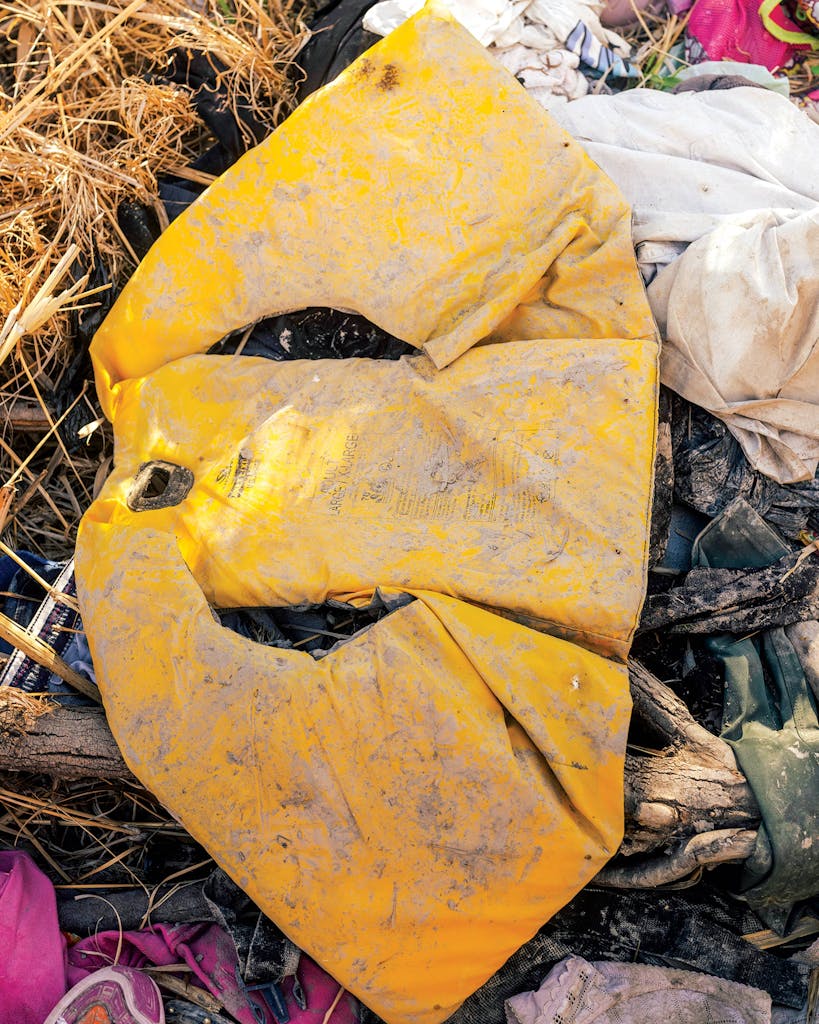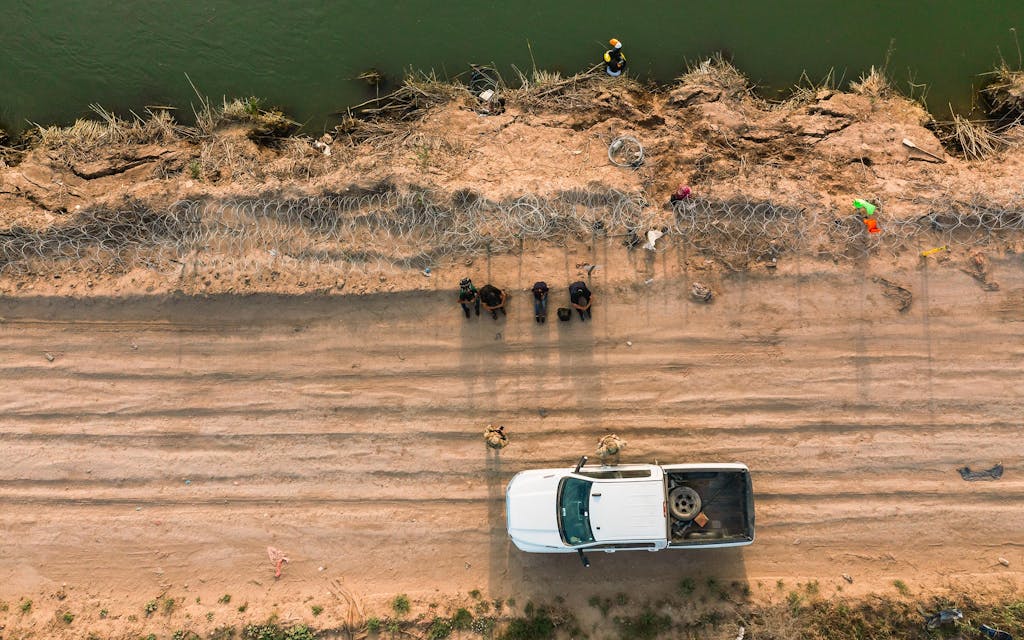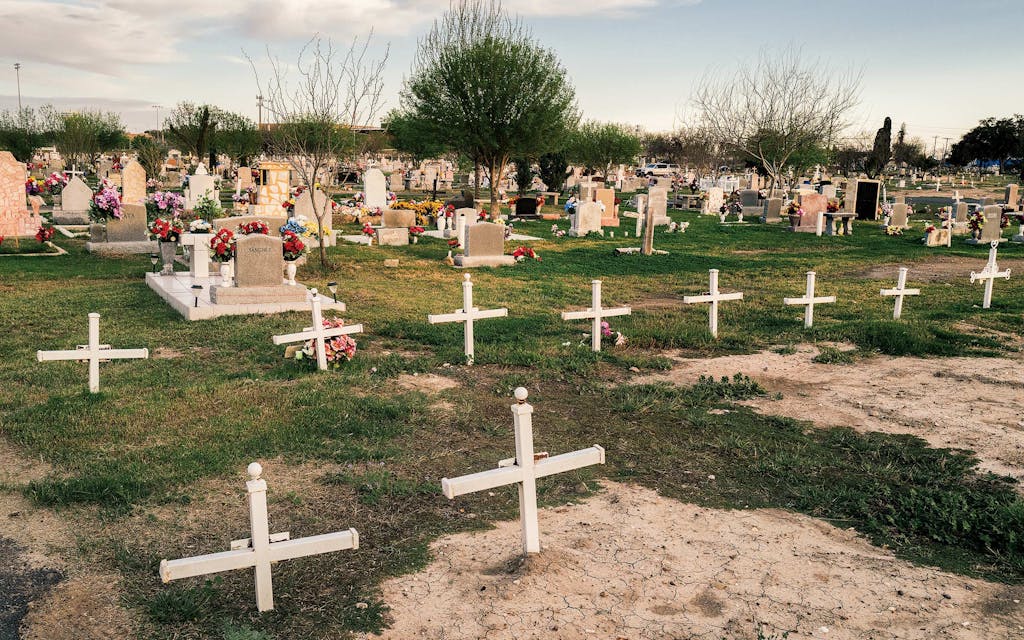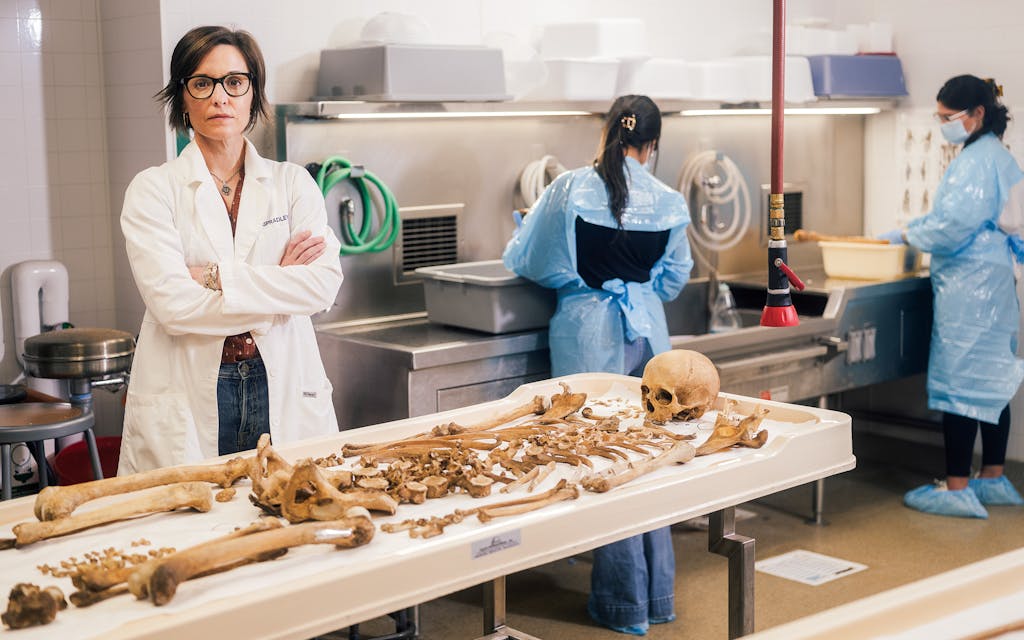He stood at the edge of the Rio Grande, mustering the nerve to wade in. It was early in the morning, and days of rain had swelled the river, amplifying the danger of trying to cross. On the opposite bank, he could see Eagle Pass, a border town roughly midway between Big Bend and Brownsville. Alan Paredes Salazar, a stocky 37-year-old, was athletic—a former player in a lower division of Peru’s professional soccer league. And yet as he faced the wild rapids, it mattered more that he was a weak swimmer who feared deep water. In Peru, where he had eked out a living selling T-shirts and working other odd jobs in coastal towns, he had steered clear of the ocean. But desperation drives people to take extraordinary risks, and Paredes was desperate. His wife and his five-year-old son back home were counting on him to eventually reach Los Angeles, where his aunts had settled and promised to help him find work.
Paredes had tried to cross into the U.S. a few months before, but never got to the country. He’d come for a second try, with his uncle Mauro Salazar Cárdenas, a nearly sixty-year-old welder who sported a shaved head. Unbeknownst to them, they had arrived at an area of the river known to some locals as the molcajete, because, like the mortar and pestle from which it gets its name, the water churns and swirls. At this part of the Rio Grande in particular, the depth is deceptive, alternating between debris-filled shallows and sudden drops of a dozen feet or more. After heavy rains or a scheduled release of water from Amistad Dam, some seventy miles upstream, the undercurrent often rushes along at swift speeds. By September 1, 2022, as Paredes contemplated crossing the river, its level had risen two feet over a couple of days, with flows more than four times greater than normal.
Paredes kept in touch with his sister in Peru via video call, right up to the moment he got to the river. What happened after he hung up remains a mystery, though witness interviews provide some clues. Paredes, Salazar, and around one hundred other migrants from countries across Latin America entered the water, many clinging to inner tubes. They were soon overwhelmed by the fast-moving current. Their screams echoed on the banks of the river and could be heard over frantic 911 calls from onlookers. Law enforcement agencies based in Eagle Pass and rescue groups from the neighboring Mexican community of Piedras Negras launched boats, saving dozens of migrants.
Back in Peru, the Paredes family anxiously awaited word. It finally came on September 3, when family members in California reported that Salazar had made it safely across the river and was in U.S. Border Patrol custody. But they weren’t sure what had become of his nephew. “My uncle told his sister in the U.S. that my brother might have drowned,” Martin Paredes Salazar, Alan’s 43-year-old brother, who works in construction in Pisco, Peru, said. “We don’t know what really happened.”
Like many families of those who drowned that day, he would spend months trying to find out.


Ever since immigration policies have been enforced along the Rio Grande, migrants have drowned trying to cross it. In 1920 eleven Mexican laborers trying to avoid border officials under cover of night perished when their skiff overturned in the river. In 1945 law enforcement agencies in Hidalgo County, home to McAllen, had hauled thirty bodies from the water by August of that year, while officials in Cameron County, just downstream, recovered nineteen in a single week. But the pace of drownings has increased rapidly in recent years, according to Stephanie Leutert, a researcher at the Strauss Center for International Security and Law at the University of Texas at Austin.
During the Clinton presidency, U.S. immigration policy was designed to funnel migrants into dangerous crossing areas—the punishingly hot Chihuahuan and Sonoran Deserts, for instance—to deter them by appealing to their survival instincts. The policy has remained in place through subsequent Republican and Democratic administrations. Leutert estimates, conservatively, that 2,700 migrants drowned in the Rio Grande between 1997 and 2022. (Based on early data she has seen, 2023 was less deadly than 2022 but still one of the deadliest years for migrant drownings.)
By 2021 the section of river that divides Eagle Pass from Piedras Negras had become ground zero for Texas’s immigration enforcement. State troopers and national guardsmen had unrolled spools of concertina wire along the banks of the Rio Grande and later would set buoys in the river. Drownings there continue to mount: according to the Eagle Pass Fire Department, at least seventeen migrants had drowned in 2024 as of mid-February.

No U.S. or Mexican agency, however, keeps a comprehensive count of migrant deaths. U.S. Border Patrol maintains a national database of such fatalities, but a damning 2022 report by the U.S. Government Accountability Office found that the agency failed to record all incidents and to report them to Congress as it is required to do by law. (U.S. Customs and Border Protection has worked to address the GAO’s recommendations. Spokespeople declined to discuss the particulars of migrant deaths that occurred in 2022 or 2023.) Between September 2021 and September 2022, the most recent period with available data, the Border Patrol recorded 895 migrant deaths along the southwest border, 172 of them “water related.” The United Nations’ International Organization for Migration determined that the U.S.-Mexico border is the world’s most dangerous land frontier for migrants.
The difficulties in accounting for drowning deaths are partly geographic. The Rio Grande flows past fourteen Texas counties and four Mexican states. The direction and strength of the current on a given day can dictate on whose shore a migrant’s corpse is found, which can determine how a death is recorded and what efforts are made to identify the body. Officials in the two nations occasionally share information, if it helps assist with an investigation, but they are not required to do so.
Consider the 2019 deaths of a Salvadoran father and his daughter in Matamoros, across the river from Brownsville. A searing image of a girl’s tiny arm wrapped around her father as they lay face down in muddy water triggered outrage in the U.S. and Latin America and condemnation of the Trump administration’s harsh immigration policies. But you won’t find the two deaths in any U.S. government data. The bodies caught a current that washed them ashore in Mexico. They are part of the official record of drowned migrants there, but not here. The same is true of a mother and her two children who drowned near Eagle Pass in January, escalating tensions between Border Patrol agents and the Texas National Guard, who had blocked the feds’ access to the river and possibly hindered their ability to save the family.
Leutert has found discrepancies among Texas counties in the information that officials were willing or able to share. Webb and Starr Counties, home to Laredo and Rio Grande City, respectively, have not always listed migrants’ causes of death. The data Leutert received from the sheriff’s office downriver in Brownsville’s county, Cameron, showed just two drownings over an eight-year period, a figure she said was almost certainly an undercount. The often-incomplete efforts at identification carried out by a patchwork of agencies make recovery of bodies by victims’ family members, such as Martin Paredes Salazar, very difficult. In many cases, if the migrant remains unidentified, those families are in a race to find a body before it is buried unceremoniously in a pauper’s grave.

The tragedy on September 1, 2022, was one of the deadliest on the river in decades. Corpses washed up on the banks for days afterward. But the various agencies involved in the recovery of migrants’ bodies have offered conflicting accounts of how many died. José Francisco Contreras Obregón, the director of Civil Protection for a region in the state of Coahuila that includes Piedras Negras, told reporters in early September that a man, a pregnant woman, and a third victim had drowned, but he provided no further details. When I spoke to him in July 2023, he confessed that more migrants had gone missing that day. “The current had taken eight or nine more, and we have heard nothing more about them.” He assured me the Coahuila attorney general’s office would have all pertinent information on file. When I checked, I found that it had recorded the drownings of only two migrants at the beginning of September, and both were men.
In Texas, Maverick County, home to Eagle Pass, recorded six drowning deaths on September 1 and September 2. Officials recovered other bodies in the week that followed, but it is difficult to know when the deaths occurred. The local fire chief, Manuel Mello III, told me that “in reality, twelve people drowned,” specifying six on each side.
From a berm in a pecan orchard that overlooks a broad section of the river where several of the September 1 victims’ bodies washed up, Mello, a seasoned emergency responder with slicked-back hair, soberly explained the recovery efforts to me. The Eagle Pass Fire Department, which usually takes the lead on retrieving bodies from the river, pulled one from the Rio Grande on September 1, according to its reports. The Border Patrol typically does not assist but had the only boats that could navigate the fast-flowing river and collected three more bodies. At least two more were eventually recovered and sent to Domingo Rodriguez Jr., a Maverick County justice of the peace, who handles cases of unidentified migrant bodies in Eagle Pass.
Rodriguez says that in September he requested that six bodies receive postmortem evaluation, but the medical examiner in neighboring Webb County reported receiving only two of them (Maverick does not have an equivalent forensic professional). Rodriguez blamed the funeral home that Maverick County uses, Memorial Funeral Chapel & Crematory Services, for the discrepancy. Aaron Valdez, an owner of Memorial, explained the business had been overwhelmed with migrants’ bodies. He said they handled the remains—sometimes without pay—as a service to the community, but that their personnel hadn’t received the proper training. He didn’t discount the possibility that the funeral home had made mistakes, but he blamed county officials for the mix-up too.
One of the migrants who died in the days surrounding September 1 was later identified as Walter González Piña. On the evening of August 31, 2022, Walter, a 21-year-old Venezuelan, had stood in water up to his chest, filming a short video for his father, Gaudy González Perez, who had arrived in the oil fields of West Texas several months earlier. “We made it, Dad,” one of the migrants declared triumphantly. Walter was joined in the river by a man reported to be Exleiker González—no relation—a 26-year-old barber and fellow countryman. The two had met in Central America and became close friends on the journey to the border.
After he sent the video, Walter went silent. Days passed. Gaudy’s worst fears that Walter had died were confirmed when he got a call from another migrant who had been at the river with his son. Gaudy went looking for Walter’s remains, first seeking help at a shelter in El Paso, which connected him with Border Patrol agents and officials in Maverick County. Walter’s face had decomposed too much for Gaudy to identify him, but photos of his body confirmed his identity. Gaudy had him cremated and keeps his ashes in a box in his house in Odessa. Exleiker also perished, Gaudy told me, though I could find no record that he had drowned.
Not all the drowning victims whose bodies were collected on or around September 1 were so easily recovered by their families. Ultimately just three of the victims in Texas were identified and returned to kin. A fourth recently underwent DNA testing at the Webb County Medical Examiner’s office but, as of Texas Monthly’s last communication with the county, remained unidentified. According to their death certificates, two more of the migrants are buried in Maverick County Cemetery.

Recovery efforts in Mexico involved a similarly confounding bureaucracy. On September 1, orange-clad workers with Grupos Beta, a governmental aid group, rescued migrants from the river and sent them to proper authorities. When bodies are recovered, they become the responsibility of the office of the Coahuila attorney general, where, Leutert said, “they fall into a kind of black hole.”
In Piedras Negras, that black hole is a peach-colored building where most days you are likely to find a dozen relatives of victims waiting for word of their loved ones or hoping to catch an official between meetings. Many pass the time at a food cart outside that sells elotes. Inside, the local branch of the country’s Forensic Medical Service searches migrants’ belongings for state-issued ID cards, and if putrefaction of the bodies is not too far advanced, officials check fingerprints against databases or share them with the U.S. Border Patrol. Then they perform autopsies.
Unclaimed dead are buried in pauper’s graves, a practice that contributes to what Alejandro Encinas, Mexico’s former undersecretary for human rights, once described as a forensic emergency. Recently Coahuila’s Regional Center for Human Identification exhumed all the unidentified remains from the municipal cemetery in Piedras Negras and sent them to Saltillo, 270 miles south, where families of the missing believe they are more likely to be identified.
Marco Echeverría directs the Coahuila attorney general’s office of disappeared and missing persons for the region including Piedras Negras. While many of those who have gone missing were not migrants, he spends much of his time these days searching for those who were. “I have a big number of unidentified and missing migrants, the largest number of them from 2022,” Echeverría said. “We don’t know where they are—if they drowned, were detained, died, live in Piedras Negras, or are in the hospital.” He pieces together what he can from the bits of information that desperate families bring to him. Still, many migrants who go missing stay that way. Echeverría referred questions about the two September 1 victims to another section of the state attorney general’s office, which did not respond to interview requests.
When county, state, and federal agencies fail to identify bodies in the U.S., the job often falls to Kate Spradley, a professor of anthropology at Texas State University, in San Marcos. For the past decade Spradley, a bespectacled fifty-year-old with a brown bob, has worked across the Texas borderlands to identify and repatriate human remains. She recently led a team investigating a spike in migrant drownings and deaths on South Texas ranches in 2022 and 2023.
In the case of those buried at Maverick County Cemetery, important clues had been missed. Spradley said she found that the Memorial funeral home sometimes buried migrants with documents that might have been used to find their families. She also discovered, upon examining some bodies, that the case files she was provided by law enforcement did not correspond to the grave markers of migrants she exhumed. The funeral home was “just haphazardly putting things out,” she said, making no attempt to disguise her annoyance. “It was crazy.” Valdez reiterated that funeral home staff was overwhelmed with migrant bodies and lacked sufficient training.
By January 2023 Spradley’s team had exhumed 26 bodies in Maverick County, including the remains of at least one man who drowned on or around September 1. That migrant had been buried in a grave along with his wallet and personal effects. According to Spradley, he had an ID that stated his name as Marvin Blandón Obregon, but he was not buried with it. The Texas Nicaraguan Community, a humanitarian-aid organization based in Katy, contacted Spradley and helped collect DNA from the victim’s mother to confirm the identity.
Rodriguez, the Maverick County justice of the peace, said ID cards are not always reliable, but he would not answer questions about Blandón specifically. Spradley said “lack of training and much-needed resources, coupled with mass death” leads to situations in which bodies that could otherwise be identified are not. It “is unfortunately quite common.”

Back in Peru, Martin Paredes Salazar had no idea where to start tracking the whereabouts of his brother. He didn’t know whether Alan was in the U.S. or Mexico or whether he was alive or dead, and the official channels in both countries proved hard to navigate. If it weren’t for Martin’s diligence, Paredes would likely be in a Texas grave like countless other migrants.
After receiving word from Salazar, his uncle, Martin pored over news reports, searching for clues that might lead him to his brother. He came across a photo of rescue workers removing a body from the river, and in it, he noticed a familiar pair of gray-and-black Adidas shoes. Salazar had a pair just like them, and Martin guessed that his uncle had lent them to Alan. “I knew when I saw the photo, that’s my brother,” he said. Noticing the orange-shirted aid workers, he made frantic calls to Grupos Beta and to migrant shelters in Mexico. Eventually, with help from his aunts in California, Martin tracked down the body in Webb County. He identified his brother from his tattoos and hair.
A funeral home in Houston prepared the body for the journey home. In November 2022 Alan’s body arrived in Lima, and Martin drove him the rest of the way south to Pisco, the port city they were from. Crowds turned out for Alan’s wake, and players from an amateur soccer club, renamed A. F. Pisqueños Alan Paredes, in his honor, carried his coffin, emblazoned with his athletic nickname, La Bala (“The Bullet”). “He was well-known, so his death impacted the community,” Martin said of his brother. He added that his father has developed a heart condition in the wake of his son’s death, and that family members still can’t bring themselves to tell Paredes’s son that his father is dead.
The tragedy also exacted a heavy financial toll. Weeks after Paredes’s death, the family started getting calls about debts Paredes owed. They managed to pay off some of that while also shouldering the funeral costs, a combined sum that Martin estimates to be around $12,000.
It was a painful, hard-won resolution to the problem Martin had been left to solve. He found his brother, so he was luckier than many. But Martin is blunt in his summation of what it took to get there. “Countries don’t give a damn that a person drowns,” he said. “It’s up to you to find your family.”
This article originally appeared in the April 2024 issue of Texas Monthly with the headline “What Happens to the Migrants Who Don’t Make It?” Subscribe today.
Aaron Nelsen is a journalist who covers the border. This story was written with support from the Fund for Investigative Journalism.
- More About:
- Longreads
- Eagle Pass







